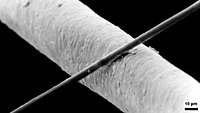
Photo from wikipedia
In the present work, a novel multiscale material methodology is applied to a finite element mesh of a cross-ply composite material in tension in order to study the progressive damage… Click to show full abstract
In the present work, a novel multiscale material methodology is applied to a finite element mesh of a cross-ply composite material in tension in order to study the progressive damage and failure of the material at multiple scales by combining damage evolution models and failure criteria in microscale and cohesive zone modeling in macroscale. The micromechanics user material (Umat) developed follows a nonlinear version of the Mori–Tanaka theory and is coupled with mesoscale damage model. The concept of this user material is to dehomogenize-localize the strain tensor at each integration point for each time increment using Eshelby’s theories and strain concentration tensors. This material implementation allows the researcher to analyze results at two scales in the post processing stage, both for the composite material and the constituents for each time increment. It is observed that in the multiscale model the results are closer to the experimental measurements and even more damage mechanisms can be predicted, such as matrix damage and fiber failure. The developed multiscale methodology is advantageous since the constituents can follow different material models, with many failure criteria. It is also capable of predicting stresses, strains, plastic strains and more analysis variables not only in the macroscale-homogeneous level but also in microscale constituent-wise level.
Journal Title: Modelling and Simulation in Materials Science and Engineering
Year Published: 2021
Link to full text (if available)
Share on Social Media: Sign Up to like & get
recommendations!